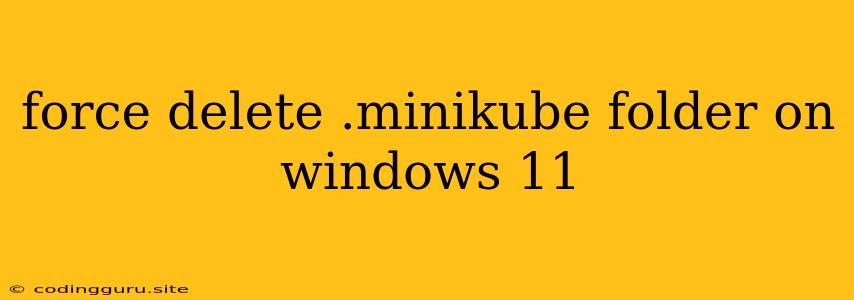Force Delete .minikube Folder on Windows 11
You're probably familiar with Minikube, a lightweight tool for running Kubernetes locally on your machine. While convenient, sometimes you might encounter issues or need a fresh start, requiring you to completely remove the .minikube folder. But what if the folder won't delete? This is where the need for a "force delete" arises.
Why Do I Need to Force Delete the .minikube Folder?
- Errors and Conflicts: Minikube can sometimes get into a state where it's unable to delete files or folders due to permissions issues or file locks. This often occurs after an interrupted installation, upgrade, or during a failed experiment.
- Starting Fresh: If you're switching between Minikube versions, troubleshooting a persistent issue, or simply want a clean slate, completely removing the .minikube folder is necessary.
- Storage Space: The .minikube folder can occupy a significant amount of disk space, especially if you've been running Minikube for a while. Deleting it can free up valuable storage.
How to Force Delete the .minikube Folder
-
Close Minikube: Ensure that Minikube is completely stopped and the VM is not running. You can check this by running
minikube status. If it's running, useminikube stopto shut it down. -
Unlock the Folder: Sometimes, files within the .minikube folder are locked by other programs or services. Try restarting your computer.
-
Use Command Prompt: Open the Command Prompt as an administrator (right-click the Start Menu and choose "Run as administrator").
-
Navigate to the Folder: Use the
cdcommand to navigate to the directory containing the .minikube folder. Typically, it's located in your user directory:cd %USERPROFILE% -
Force Delete: Use the
rmdircommand with the/Sand/Qflags to recursively delete the folder and its contents. For example:rmdir /S /Q ".minikube"/S: This flag tellsrmdirto delete all subfolders within the .minikube folder./Q: This flag suppresses confirmation prompts, making the deletion faster.
Important Precautions
- Backup: Before attempting to force delete, it's wise to create a backup of the .minikube folder in case you need to restore any files later.
- Double-Check: Make absolutely sure you are targeting the correct folder. Mistakenly deleting the wrong folder can lead to data loss.
- Alternative Methods: If the
rmdircommand doesn't work, you can try using a third-party file explorer with advanced features like "Force Delete" or "Unlock" options.
Troubleshooting Tips
- Permissions: If you're still encountering issues, check file permissions in the .minikube folder. You might need to take ownership or grant administrator access to delete the folder.
- Antivirus: Your antivirus software might be interfering with the deletion process. Temporarily disable it to see if it resolves the issue.
- System Reboot: Sometimes, a system reboot can help to release file locks and allow for a successful deletion.
Conclusion
Force deleting the .minikube folder can be necessary for troubleshooting, starting fresh, or reclaiming disk space. By following the steps outlined above and taking appropriate precautions, you can successfully remove the folder and its contents on Windows 11. Remember to use caution and double-check your actions before proceeding.
